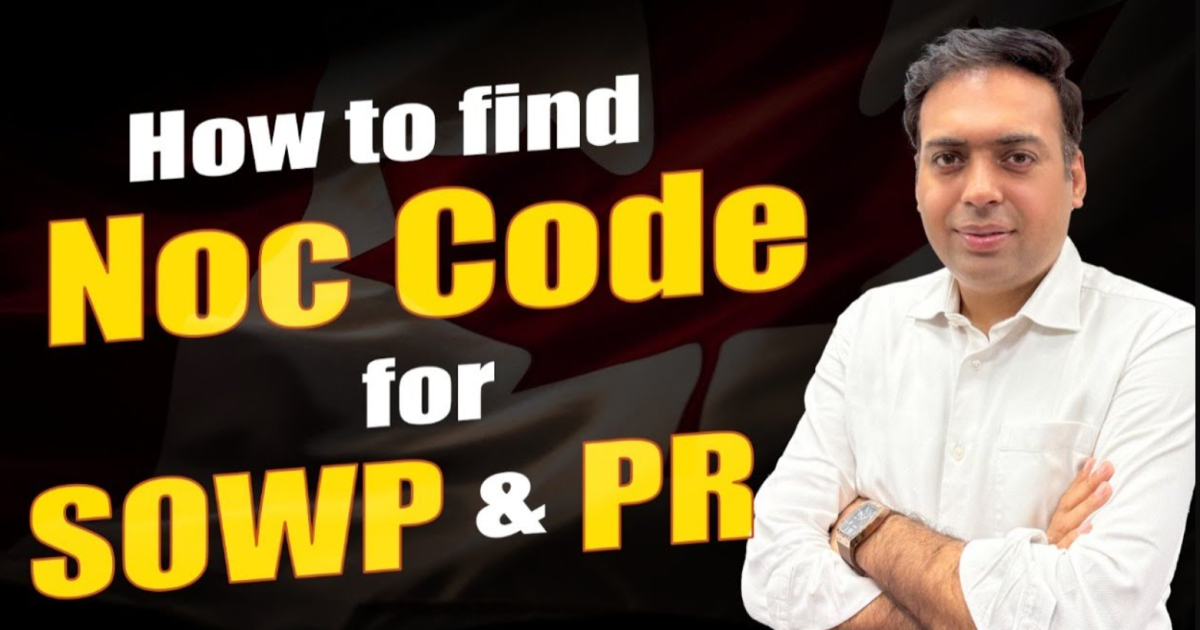Table of Contents
ToggleHow to Find a NOC Code for SOWP & Canada PR? – A Complete Guide

Applying for a Spousal Open Work Permit (SOWP) or Permanent Residency (PR) in Canada requires more than just filling out forms. One of the most crucial steps in your application is selecting the correct NOC (National Occupational Classification) code. Many applicants underestimate this step, but choosing the wrong NOC can lead to serious issues, including refusal of your application.
At Globexa Immigration, we help students, workers, and families navigate Canadian immigration requirements with accuracy. In this blog, we’ll explain everything you need to know about finding the right NOC code for your application.
1. What is a NOC Code in Canada?
The NOC (National Occupational Classification) is Canada’s official system for classifying jobs. Every occupation in Canada is assigned a 5-digit code that represents:
Job title
Duties and responsibilities
Skill and education requirements
Industry classification
The NOC helps Canadian immigration officers verify your job experience when you apply for SOWP, PR, Express Entry, or Provincial Nominee Programs (PNPs).
2. Why NOC Matters for SOWP and PR
1. For SOWP (Spousal Open Work Permit):
If you are applying for a spousal open work permit, your spouse (the principal applicant in Canada) must be:
A full-time worker in a skilled occupation (TEER 0, 1, 2, or 3), or
An international student in a program that leads to eligible work opportunities.
Immigration officers will check the NOC code of the spouse’s job to confirm that it qualifies as a skilled occupation.
2. For PR (Permanent Residency):
When applying for Canada PR under Express Entry or PNPs, you must select a NOC code that accurately reflects your past work experience.
Your eligibility, CRS score, and PNP nomination depend on your NOC.
A wrong NOC can cause application refusal since officers compare your work reference letters with NOC duties.
2. NOC 2016 vs. NOC 2021 – What Changed?
Canada updated its classification system in 2021, moving from a 4-digit to a 5-digit NOC code.
Key changes include:
New TEER categories (Training, Education, Experience, Responsibilities) replaced skill levels.
More detailed breakdown of occupations.
Some occupations have new NOC codes compared to 2016.
TEER Categories Overview:
TEER 0 – Management occupations
TEER 1 – Jobs requiring university degree
TEER 2 – College diploma/apprenticeship with 2+ years training
TEER 3 – College diploma or less than 2 years training
TEER 4 – Secondary school education + on-job training
TEER 5 – Jobs requiring short-term training or no formal education
For SOWP & PR, the jobs must fall under TEER 0–3 (skilled jobs).
3. Step-by-Step: How to Find the Right NOC Code
Here’s a clear process to identify the correct NOC code for your application:
1. Visit the Official Government NOC Website
Use the official NOC search tool:
🔗 https://www.jobbank.gc.ca/noc
2. Search by Job Title or Industry
Enter your job title (e.g., Software Engineer, Financial Analyst, Welder) to see related NOC codes.
3. Review Job Duties Carefully
Each NOC lists main duties and employment requirements.
Your job duties must match at least 70–80% of the listed NOC duties.
Do not rely only on the job title, since titles vary by employer.
4. Confirm TEER Category
Ensure your NOC falls under TEER 0–3 for SOWP and PR eligibility.
5. Cross-Check with Your Experience Letter
Your employer’s job description in your reference letter should match the NOC duties. If they don’t align, the officer may reject your application.
6. Keep Record of the NOC Code
Once finalized, note down the NOC code and its duties. Use the same information consistently across your IMM forms, Express Entry profile, and supporting documents.
4. Examples of NOC Codes for Popular Occupations
Here are some common skilled jobs and their NOC codes (2021 version):
Software Engineers → NOC 21231 (TEER 1)
Restaurant Managers → NOC 60030 (TEER 0)
Registered Nurses → NOC 31301 (TEER 1)
Financial Analysts → NOC 11101 (TEER 1)
Welders → NOC 72106 (TEER 2)
Early Childhood Educators → NOC 42202 (TEER 2)
Administrative Assistants → NOC 13110 (TEER 3)
5. Common Mistakes Applicants Make with NOC Codes
❌ Choosing NOC based only on job title.
❌ Picking a NOC just because it looks more “skilled.”
❌ Not checking job duties properly.
❌ Using outdated 2016 NOC codes instead of the 2021 system.
❌ Submitting reference letters that don’t align with the chosen NOC.
6. Tips to Select the Correct NOC
Focus on job duties, not the title.
Match at least 70–80% of duties with your real job.
Ask your employer to draft a detailed experience letter that matches the NOC.
Always use the official Canadian NOC website for confirmation.
When in doubt, consult a professional immigration advisor.
Final Thoughts
Finding the right NOC code is one of the most important steps in your SOWP or Canada PR journey. A wrong code can cause refusals, delays, or wasted time, while the correct code strengthens your application and increases your chances of approval.
At Globexa Immigration, we specialize in helping applicants match their work experience with the correct NOC code and prepare strong applications for Canada work permits and PR.



One Reply to “How to find a NOC Code for SOWP & Canada PR?”
I constantly spent my half an hour to read this
blog’s articles all the time along with a mug of coffee.